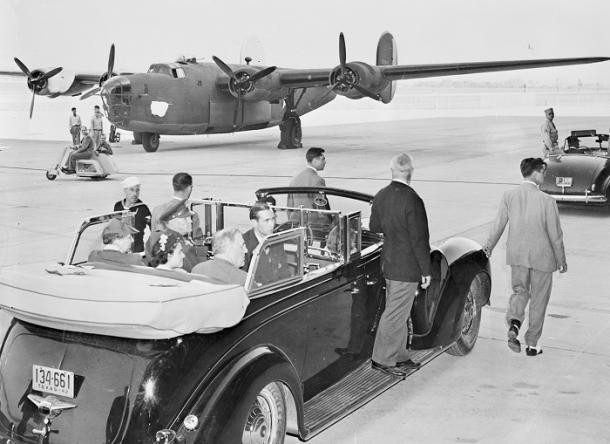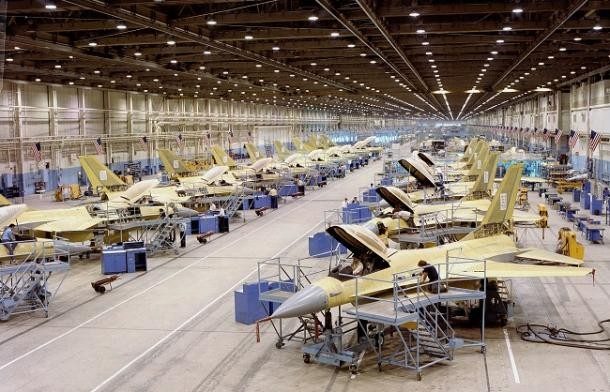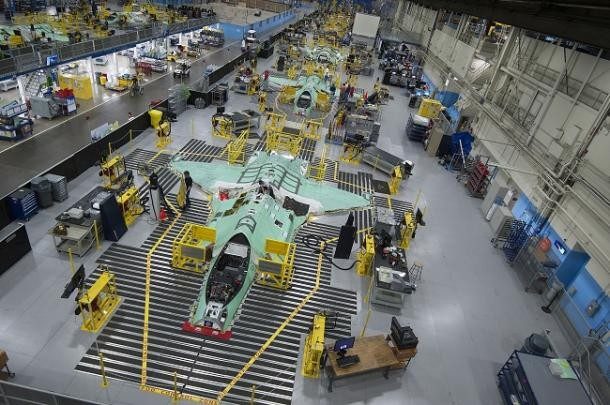1940s and 1950s: The Bomber Plant

Franklin Delano Roosevelt visited Air Force Plant 4 in 1942 for the delivery of the first B-24.
Air Force Plant 4 began operations in west Fort Worth on April 18, 1942. Construction was completed in less than a year. To satisfy the blackout conditions necessary for wartime, the plant had no windows. As such, it needed a lot of lights and air conditioning – the bill of which was equivalent to $282,000 per month in today’s dollars.
Bombers were the focus in the 1940s and 1950s, earning the facility a nickname among locals that endures today: the “bomber plant.” Production of the B-24 Liberator began in February 1942 while parts of the facility were still under construction. Eventually 2,743 B-24’s were produced in Fort Worth. President Franklin Delano Roosevelt visited Air Force Plant 4 in 1942 for the delivery of the first B-24.
Additionally, during the latter part of WWII, the plant began producing another bomber, the B-32 Dominator. A total of 124 of these four-engine bombers were produced – all in Fort Worth.
Almost 400 B-36 Peacemakers, the world’s first intercontinental bomber, were produced in Fort Worth in the late 1940s and early 1950s. The B-36 Peacemaker could fly missions up to 5,000 miles away, and stay in the air up to 52 hours. It was eventually phased out in 1958.
In the late 1950s, production of the B-58 Hustler began. The aircraft made it first flight in 1956 and became operational in 1959. Eventually 116 were built. The B-58 was the world’s first operational jet bomber capable of Mach 2 speeds. It set 15 speed records, including a flight from New York to Paris in 3 hours, 19 minutes. The last B-58 was retired in 1970.
More than 30,000 people worked at the Air Force Plant 4 during the WWII years – about one in five Fort Worth residents. Women comprised a third of the work force during that time. An area was built south of the plant, called Liberator Village, to house many of these workers, who could become part of dance clubs; golf, baseball, basketball, softball and bowling teams; or tend the employee garden. While the number of employees would ebb and flow a bit during the 1940s and 1950s, more than 31,000 worked at the plant in 1957.
Support of the local Fort Worth community has been a focus at the plant since it opened in the 1940s. For example, in 1949, employees at the plant pulled together to help downtown Fort Worth recover from a significant Trinity River flood that destroyed thousands of homes. This was just one example of the long-term partnership and connection between the plant and the city, which continues today.
In the 1950s, employees began contributing from their paychecks to the local United Way organization through the Aero Club. Since the 1950s, Fort Worth employees have given more than $75 million to the United Way.
1960s-1980s: The Fighter Factory

The F-16 production line in Fort Worth in the 1980s. The fighter was so innovative and successful that eventually more than 4,500 were produced for more than 25 countries.
In the early 1960s, development and production began on the F-111 Aardvark, a supersonic, tactical attack aircraft. A total of 564 were produced in Fort Worth, earning the plant a new nickname: the “fighter factory.”
The F-111 entered service with the U.S. Air Force in 1967 and flew more than 30 years, eventually retiring in 1996 – although Australia operated the aircraft through 2010. About 30,000 worked at the AF Plant 4 at the highest employment point in the 1960s, mostly supporting development and production of the F-111 and its variants.
A smaller program developed and built in Fort Worth during the 1960s was the RB-57F Canberra. This jet was a specialized strategic reconnaissance aircraft specified for the U.S. Air Force, through the Big Safari program. It was assigned to the Air Weather Service for weather reconnaissance involving high-altitude atmospheric sampling and radiation detection in support of nuclear test monitoring. A total of 21 were built; three are still in service with NASA.
Development on the F-16 began in the early 1970s. The goal with F-16 was to create a simpler and smaller alternative to the larger and more complex fighter aircraft common during that time. The F-16 did just that and proved to be a game-changer among fighter jets with its smooth blended-wing body; fly-by-wire system that kept the design stable, improved response time and increased agility; and an enhanced cockpit.
The F-16 was so innovative and successful that eventually more than 4,500 were produced – 3,630 in Fort Worth – for more than 25 countries. At the peak production level in 1987, the F-16 production team was able to deliver 30 fighters per month. While production continues today, the last F-16 built in Fort Worth will be delivered in fall 2017.
During the mid-1970s, the number of employees at the plant had dwindled to about 8,000 – as F-111 production wrapped up and the F-16 was still under development. The number rebounded in the 1980s, however, with more than 30,000 employed by 1986, mostly for F-16.
1990s: Reinvention and Innovation
After the end of the Cold War, the Fort Worth plant had to reinvent itself yet again. In the early 1990s, F-16 production had slowed, new program wins were scarce, and the A-12 development program was cancelled in 1991 – resulting in thousands of jobs lost. It was a difficult time for the plant and the Fort Worth community.
But employees looked for innovative ways to secure new business with existing programs, and that ultimately secured the future of the plant in Fort Worth. F-16 sales expanded into new markets in Asia and the Middle East. Fort Worth earned a contract to build the mid-fuselage for F-22 Raptor before it was shipped to Marietta for final assembly. And a focus on advanced manufacturing techniques, design innovation and Lean approaches helped position Lockheed Martin to win the F-35 Joint Strike Fighter contract in 2001 – setting the stage for decades of future growth.
2000s and Beyond: Strength for Decades

The F-35 production line in 2011. F-35 production in Fort Worth will increase to about 160 a year by 2019 and could exceed 4,000 aircraft over several decades - representing a huge impact to the economy and community of Fort Worth.
The last two decades in Fort Worth have been heavily focused on F-35 development and production. The F-35 is the world’s most advanced multi-role fighter – providing unmatched capabilities to military forces around the world, securing high-tech, high-skill jobs for hundreds of thousands of people worldwide, and elevating international security by allowing for more integrated coalition operations.
We’re building on our 75 years of innovation through continued new approaches to hiring, training, manufacturing and more. In 2017, almost 70 F-35s will be built in Fort Worth; that will increase to about 160 a year by 2019 and could exceed 4,000 aircraft over several decades. Nationwide, the F-35 is responsible for more than 170,000 direct and indirect jobs; the program represents more than $3 billion in economic impact to the state of Texas.
Community support continues to be a priority for employees and Lockheed Martin. Fort Worth employees volunteered more than 110,000 hours in 2016 and personally donated nearly $3 million to community organizations. Additional Lockheed Martin corporate donations of more than $1 million a year support Fort Worth education initiatives and other charities.
Our employee experience is at the forefront of our priorities today – because the people working on our programs will ultimately determine our success in the long-term. The F-35 program will allow us to continue operating for many years as an employer of choice in the Dallas-Fort Worth area, and ensures the Fort Worth community has strong support in place for decades.




